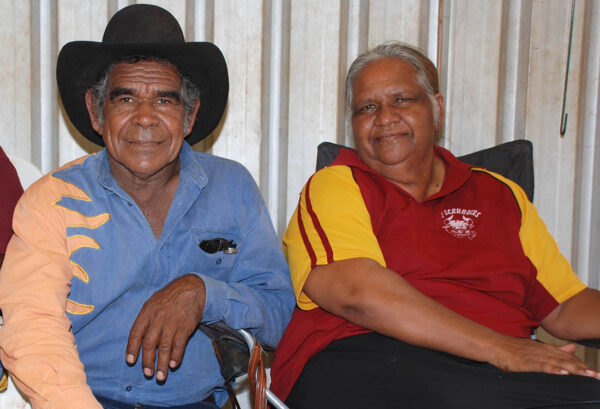
Shirley Dempsey (pictured right) knows the benefits of very remote outstation living. But she also knows the big risks. In recent years, now 64-year-old Ms Dempsey collapsed and had to be flown to Adelaide. Fortunately she was in Alice Springs at the time.
But the timing might have been bad. She might have been at home, nearly 540 kilometres away at her outstation Urlampe, 30 kilometres from the Northern Territory-Queensland border as the as the crow flies, off the unsealed Plenty Highway, and arguably closer to Mount Isa.
So Ms Dempsey and her partner Alan Rankin decided to devote all the $150,000 allocated to their outstation in the Aboriginals Benefit Account outstations project to upgrading their airstrip so it’s Royal Flying Doctor ready.
Other outstations, such as Walka, equally remote in the opposite direction, near the Northern Territory-Western Australia border, south of Kaltukatjara (Docker River), will support their small scale tourism enterprises with the same allocation. Most welcome the funding opportunity to simply make ultra-remoteness more liveable, such as Brumby Plains outstation where resident Desley Rogers is a director of the surrounding successful Mistake Creek Aboriginal-owned cattle station. The station is much closer to Kununurra in Western Australia’s Kimberley region than to Alice Springs.
With about one-third of its $150,000 allocation, Brumby Plains has upgraded its telecommunications to a system allowing mobile telephony and internet access. “With that up and running now, it’s really good,” says Ms Rogers. “I can do a lot of things on my mobile, like check my emails. It’s really good.” Like Urlampe’s airstrip, Ms Rogers also fully appreciates the safety implications of much better communications in such remote circumstances.
The 105 outstations, also known as homelands, in the Central Land Council area each given the chance to receive the $150,000 have the CLC executive to thank for initiating the ABA outstations project. The committee lobbied the Australian Government hard to have $15.75 million provided to outstations in the CLC area from the ABA. The same went to outstations in the Northern Land Council area, and smaller amounts to those in the NT’s two smaller land council areas.
The ABA receives from the government the equivalent amount paid to the government in royalties from mining on Aboriginal land in the NT, for the benefit of NT Aboriginal people. The ABA advisory committee comprised of representatives of the NT’s four land councils makes recommendations to the federal Minister for Indigenous Australians, Ken Wyatt, who ultimately decides on ABA grants. Then it’s usually over to the grantees to do what’s specified in the grant agreement.
The ABA outstations project has involved additional governance and project management complexities, handled in different ways by the different land councils.
The CLC had to find a fair and transparent way to choose the 105 outstations to potentially receive the funding out of the 309 total outstations in the CLC area. If the $15.75 million was shared among all 309 the resulting works wouldn’t have been worth doing. And a fair, clear and comprehensible way of spreading the 105 around the CLC’s nine regions had to be found, considering some regions have many more outstations than others. The project could not initiate new outstations. The project is only for outstation upgrades, with the funding allocated only to those places passing the assessment criteria of need, benefit and capacity.
So, the CLC began the project by surveying as many of the 309 outstations in its area that it could, in regional information sessions with their residents or some-time residents. The survey covered a wide range of data, including existing outstation infrastructure and its condition, supports from service providers and residents’ employment. It has resulted in CLC’s first comprehensive, centralised spreadsheet of outstation data, long overdue, but already due an update to remain relevant and widely applicable to CLC’s various operations.
Summaries of the data, and recommendations based on the assessment criteria, were taken to a council meeting, where the CLC delegates chose the outstations in agreed numbers per sub-region to make up the 105. Fully briefed and integrally involved, they did so without dispute, though over 200 other outstations missed out on the funding entirely.
The CLC subsequently consulted at the chosen 105 towards detailed applications for each addressing the assessment criteria. At last count, the minister had approved 90 of these, with the remaining 15 held up by COVID-19.
Those approved go to the National Indigenous Australians Agency. The NIAA is charged with engaging suitable providers of the works at clusters of the approved outstations, ideally Aboriginal organisations hiring members of the outstations to do some of the work.
With the completion of all works, it is expected more than 100 Central Australian outstations will be better equipped as sanctuaries in the event of crises like COVID-19, indeed safer and more liveable for the Aboriginal residents on their country, crisis or not. Residents like Desley Rogers and Shirley Dempsey of remote Brumby Plains and Urlampe outstations respectively.
Update, 18 November 2022
By design with the CLC at its outset, this project as a whole is now the responsibility of the NIAA, with outstation providers at each of the more than 100 outstations to receive project support.
The CLC has not had responsibility for this project since fulfilling its role by November 2019. Yet it continues to receive inquiries from outstation residents about the project’s progress. It is directing them to call the NIAA on 1800 354 612.
